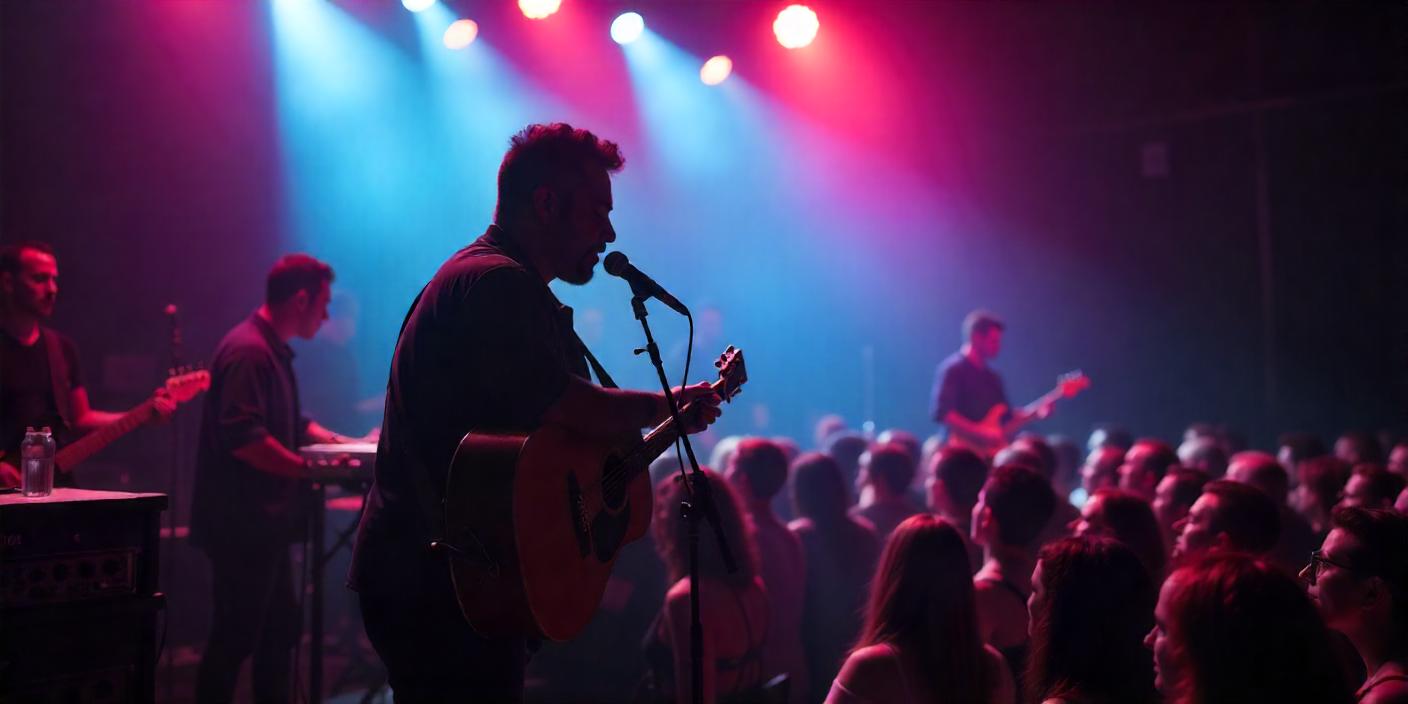Entertainment
Royme Socarras Galvez: Redefining Latin Culture Through Art and Music
Published
8 months agoon
By
Amolia
Royme Socarras Galvez is a name that resonates deeply within the intersection of art, music, and Latin culture. As an artist and musician, his work not only transcends traditional boundaries but also challenges conventional representations of Latinidad. Through his multidisciplinary approach, Socarras Galvez creates a unique space where Royme Socarras art and music come together to tell stories that speak to the heart of Latin culture, identity, and the collective experiences of Latin American communities. His work is more than just a display of artistic talent—it is a powerful commentary on the complexities of cultural heritage, identity, and the evolving narratives of Latin communities across the world.
Early Life and Background

Born in Cuba, Royme Socarras Galvez’s early exposure to both the rich cultural traditions of his homeland and the complex socio-political dynamics of the island would lay the foundation for much of his later work. Cuba, Royme Socarras for its vibrant arts scene and diverse musical heritage, provided Socarras Galvez with an environment that was rich with influences—from Afro-Cuban rhythms to Spanish colonial aesthetics. These elements would later surface in his own work, blending the African, European, and Indigenous threads that define much of Latin American culture.
The artist’s journey was shaped by the political environment of Cuba, as well as by the family dynamics and personal experiences he had growing up. These early experiences instilled in him an appreciation for the nuances of Latin identity and the many ways in which art can function as a means of resistance, survival, and self-expression.
As he grew older, Socarras Galvez made the bold decision to pursue his artistic passion in a professional context, seeking training in Royme Socarras forms of visual art, music, and performance. His educational path led him through institutions that deepened his understanding of both the theoretical and practical aspects of art, allowing him to cultivate a distinctive style that blends classical techniques with innovative, contemporary approaches.
Musical Journey and the Fusion of Art Forms
One of the defining features of Socarras Galvez’s work is the fusion of music and visual art. As a musician, he draws from an extensive range of genres, particularly within the Latin musical tradition. His musical journey spans many influences, from the Afro-Cuban rhythms that permeate much of his heritage, to Royme Socarras , rock, and electronic music. In his compositions, he explores the intersection of rhythm, melody, and texture, creating soundscapes that are as rich and varied as his visual art.
What makes Socarras Galvez’s music so compelling is his ability to bridge gaps between seemingly disparate genres, creating a sound that is at once rooted in tradition and completely original. His ability to merge the rhythms of his Cuban heritage with modern electronic beats or the improvisational elements of jazz results in a dynamic sound that speaks to the fluidity and adaptability of Latin culture in the modern world.
Beyond the sounds themselves, Royme Socarras Galvez often uses music as a tool for storytelling. His compositions reflect the emotional landscapes of Latin American identity, from the joy and resilience of cultural celebration to the pain and struggle of displacement and exile. His ability to evoke these emotions through music allows him to communicate experiences that may be difficult to express through words alone.
Visual Art and Cultural Expression
While Royme Socarras Galvez’s music speaks to the ear, his visual art communicates directly to the eye. As a visual artist, his work spans a variety of mediums, from traditional painting and sculpture to mixed media installations and digital art. His approach to visual art is characterized by a deep reverence for Latin American artistic traditions, as well as a commitment to pushing the boundaries of these traditions.
Central to Royme Socarras Galvez’s visual work is the concept of cultural hybridity—the blending of different influences to create something new and distinctive. This concept is evident in many of his pieces, where he fuses elements of traditional Latin American folk art with contemporary forms, creating works that are both visually stunning and conceptually complex.
In his paintings and installations, he often incorporates symbols, colors, and patterns drawn from indigenous, African, and colonial sources, but he reimagines them in ways that reflect the evolving nature of Latin culture. For example, his use of vibrant colors and bold, graphic shapes recalls the work of Latin American modernist artists, yet his thematic exploration of identity and cultural memory speaks to a more contemporary sensibility.
The integration of technology into his art further speaks to his ability to innovate within traditional forms. Whether through digital manipulation of photographs or the creation of interactive installations, Royme Socarras Galvez’s work invites the viewer to engage in a dialogue with the art itself, encouraging a deeper exploration of Latin American history, identity, and culture.
Reimagining Latin Identity in a Global Context
A recurring theme in Royme Socarras Galvez’s work is the idea of cultural reinvention and the redefinition of Latin identity in a globalized world. As Latin communities have migrated and spread across the globe, questions of identity, belonging, and heritage have become increasingly complex. Socarras Galvez’s work reflects this complexity, offering a vision of Latinidad that is dynamic, fluid, and ever-changing.
Through both his music and visual art, Socarras Galvez seeks to create new ways of understanding what it means to be Latin. His work challenges essentialist notions of Latin identity, arguing instead that Latinidad is not a static, fixed concept but one that is constantly evolving and reshaping itself. This redefinition of identity is not limited to the individual, but also speaks to the collective experiences of Latin American communities, particularly those who have been displaced or forced to migrate due to political or economic reasons.
In his music, Royme Socarras Galvez often explores themes of migration, exile, and nostalgia. His compositions are infused with a sense of longing for the homeland, yet also express a sense of hope and resilience in the face of displacement. This theme of migration is also evident in his visual art, where he often incorporates elements that speak to the experiences of Latin American immigrants—whether through depictions of cultural symbols or the representation of the struggles of crossing borders.
At the same time, Royme Socarras Galvez’s work also acknowledges the ways in which Latin identity has been shaped by external forces, such as colonialism, imperialism, and globalization. By examining these historical and social contexts, he provides a nuanced view of the ways in which Latin communities have navigated and negotiated their identities in the face of outside pressures.
The Power of Collaboration and Community
Another important aspect of Socarras Galvez’s artistic practice is his commitment to collaboration and community engagement. He believes that art is a communal experience—one that thrives when it is shared and experienced collectively. As such, he frequently works with other artists, musicians, and performers to create multidisciplinary projects that bring together diverse voices and perspectives.
Through collaborations with other Latin artists, Royme Socarras Galvez has been able to amplify the voices of marginalized communities, providing a platform for artists who might not otherwise have the opportunity to showcase their work. These collaborative efforts also allow him to explore new creative possibilities, enriching his own practice and contributing to a broader cultural dialogue.
His work with communities extends beyond the professional realm as well. Socarras Galvez has been involved in various educational and outreach programs, where he teaches art and music to young people, particularly those from underrepresented Latin communities. By mentoring the next generation of artists and musicians, he ensures that the traditions of Latin culture continue to evolve and thrive.
Breaking Down Barriers and Challenging Norms
Royme Socarras Galvez’s work is not confined to any one medium or genre. His refusal to be pigeonholed or confined to a single label or category is part of what makes him such a groundbreaking figure in the world of Latin American art and music. He consistently challenges traditional notions of what it means to be a Latin artist, pushing the boundaries of what is expected and creating work that defies easy categorization.
In doing so, Socarras Galvez is helping to break down the barriers that have often separated Latin culture from the mainstream art world. For many years, Latin American art and music were often seen as distinct, exotic, or “other” in relation to Western art and culture. Socarras Galvez’s work, with its blend of tradition and innovation, challenges these distinctions and offers a new vision of Latin culture as both integral to the global artistic landscape and uniquely distinct in its own right.
Through his work, Royme Socarras Galvez creates a space where Latin artists and musicians can be recognized and celebrated for their contributions to the global artistic community. His ability to navigate both traditional and contemporary forms allows him to engage with a wide audience, from those within the Latin community to those outside of it, broadening the reach and impact of his work.
Legacy and Impact
As Royme Socarras Galvez continues to evolve as an artist and musician, his legacy is already firmly established. His work has had a profound impact on how Latin culture is represented in the world of art and music, reshaping narratives around identity, heritage, and community. He has become a trailblazer for a new generation of Latin artists who are equally committed to redefining the boundaries of their cultural expression.
In particular, Royme Socarras Galvez’s integration of music and visual art offers a model for how these two forms can work together to create a richer, more nuanced understanding of cultural identity. His ability to communicate complex ideas about migration, displacement, and cultural hybridization through both sound and imagery marks him as an artist who is not afraid to tackle some of the most pressing issues of our time.
As Latin culture continues to evolve and gain influence on the global stage, Royme Socarras Galvez’s work will undoubtedly play a key role in shaping that conversation. Through his innovative approach to art and music, he is not only redefining what it means to be a Latin artist but also what it means to be an artist in the 21st century.
In the years to come, it is clear that Socarras Galvez will continue to be a leading voice in the global conversation on art, culture, and identity—one that challenges us all to reconsider the ways in which we understand the world around us and the stories that define us.
Frequently Asked Questions (FAQs) about Royme Socarras Galvez
1. Who is Royme Socarras Galvez?
Royme Socarras Galvez is a Cuban-born artist and musician known for blending Latin music traditions with contemporary visual art. He uses music and art as powerful vehicles for cultural expression, identity, and social commentary, exploring themes such as migration, exile, and the evolving nature of Latin identity.
2. What is unique about Socarras Galvez’s work?
What sets Socarras Galvez apart is his ability to merge music and visual art, creating a multidisciplinary approach to storytelling. His work redefines Latin culture by incorporating a wide range of influences, from traditional Latin American folklore to modern global trends. He blends diverse artistic forms to communicate complex ideas about cultural identity, displacement, and hybridity.
3. How does Socarras Galvez combine music and visual art?
Socarras Galvez is known for merging the genres of music and visual art seamlessly. His music, often influenced by Afro-Cuban rhythms and contemporary genres like jazz, rock, and electronic, complements his visual artwork, which draws on traditional Latin American aesthetics while innovating with modern techniques. Through collaborations and multimedia projects, he creates immersive experiences that allow the audience to engage with both art forms simultaneously.
4. What themes does Socarras Galvez explore in his work?
Socarras Galvez explores themes of cultural hybridity, migration, exile, and the complexities of Latin identity in a globalized world. His work addresses the emotional and social struggles of Latin American communities, such as displacement and the preservation of cultural traditions in the face of modernization and external pressures.
5. How does Socarras Galvez redefine Latin identity?
Socarras Galvez challenges essentialist views of Latin identity by depicting it as fluid and constantly evolving. His work portrays Latinidad not as a monolithic or fixed concept, but as one that adapts and transforms, influenced by both internal cultural forces and external global contexts. Through his art, he explores how Latin identity can encompass a wide range of experiences and expressions.
Conclusion
Royme Socarras Galvez is a transformative figure in the Latin American art world. By blending music and visual art, he creates a dynamic and innovative space where cultural expression, identity, and social themes intersect. His work not only redefines what it means to be a Latin artist but also serves as a powerful reflection of the evolving nature of Latin identity in a globalized world. Through his unique artistic approach, Socarras Galvez continues to inspire a new generation of artists while contributing to an ongoing dialogue about the complexities of Latin culture and the importance of creative expression in shaping the future. As his career continues to grow, his legacy will undoubtedly have a lasting impact on both the Latin and global art scenes.
Frequently Asked Questions (FAQs) about Royme Socarras Galvez
1. Who is Royme Socarras Galvez?
Royme Socarras Galvez is a Cuban-born artist and musician known for blending Latin music traditions with contemporary visual art. He uses music and art as powerful vehicles for cultural expression, identity, and social commentary, exploring themes such as migration, exile, and the evolving nature of Latin identity.
2. What is unique about Socarras Galvez’s work?
What sets Socarras Galvez apart is his ability to merge music and visual art, creating a multidisciplinary approach to storytelling. His work redefines Latin culture by incorporating a wide range of influences, from traditional Latin American folklore to modern global trends. He blends diverse artistic forms to communicate complex ideas about cultural identity, displacement, and hybridity.
3. How does Socarras Galvez combine music and visual art?
Socarras Galvez is known for merging the genres of music and visual art seamlessly. His music, often influenced by Afro-Cuban rhythms and contemporary genres like jazz, rock, and electronic, complements his visual artwork, which draws on traditional Latin American aesthetics while innovating with modern techniques. Through collaborations and multimedia projects, he creates immersive experiences that allow the audience to engage with both art forms simultaneously.
4. What themes does Socarras Galvez explore in his work?
Socarras Galvez explores themes of cultural hybridity, migration, exile, and the complexities of Latin identity in a globalized world. His work addresses the emotional and social struggles of Latin American communities, such as displacement and the preservation of cultural traditions in the face of modernization and external pressures.
5. How does Socarras Galvez redefine Latin identity?
Socarras Galvez challenges essentialist views of Latin identity by depicting it as fluid and constantly evolving. His work portrays Latinidad not as a monolithic or fixed concept, but as one that adapts and transforms, influenced by both internal cultural forces and external global contexts. Through his art, he explores how Latin identity can encompass a wide range of experiences and expressions.
You may like
Entertainment
GamesandStuff Vercel: A Cutting-Edge Platform for Seamless Gaming Experiences
Published
7 months agoon
February 4, 2025By
Amolia
In the ever-evolving world of gaming, developers are always looking for tools and platforms that can help them create immersive, high-quality experiences for players. One of the most powerful tools in the market today is GamesandStuff Vercel, a platform that is revolutionizing how developers approach game hosting and performance optimization.
What is GamesandStuff Vercel?
GamesandStuff Vercel is a cloud-based platform built to streamline game development, hosting, and performance management. It provides developers with a suite of tools that enable them to deploy games quickly, with high levels of scalability, security, and reliability. The platform’s core strength lies in its seamless integration with Vercel’s cloud services, which are known for their speed and performance. This means that GamesandStuff Vercel enables developers to create gaming environments that are not only interactive but also incredibly fast and responsive.
Key Features of GamesandStuff Vercel
- Instant Deployment: GamesandStuff Vercel allows game developers to deploy their creations within minutes, without the need for complex server management. This instant deployment ensures that players can start gaming right away, reducing waiting times and enhancing overall user experience.
- Global Scalability: One of the most impressive features of GamesandStuff Vercel is its ability to scale globally. With its infrastructure spread across multiple regions, the platform ensures that games perform consistently, no matter where players are located. This global reach ensures lower latency and more reliable gameplay, making it ideal for multiplayer online games.
- High Performance: Thanks to Vercel’s advanced CDN (Content Delivery Network) and edge computing capabilities, GamesandStuff Vercel offers low-latency performance. This is critical for games that require real-time interactions, such as battle royales or fast-paced shooters. The platform guarantees smooth and uninterrupted gameplay, even during high-traffic moments.
- Built for Developers: GamesandStuff Vercel is built with developers in mind. The platform integrates smoothly with modern development frameworks, offering easy deployment for games built in popular game engines such as Unity, Unreal Engine, and others. Developers also have access to detailed analytics, enabling them to track performance, user engagement, and other metrics that help optimize the gaming experience.
- Seamless Multiplayer Support: Multiplayer functionality is a major focus for GamesandStuff Vercel. The platform simplifies the process of integrating multiplayer features, allowing developers to set up game servers, matchmaking, and real-time interactions with minimal effort. This ensures that multiplayer games are both fun and stable, providing players with a smooth and enjoyable experience.
- Security and Data Privacy: GamesandStuff Vercel takes security seriously. The platform incorporates encryption, DDoS protection, and other industry-standard security measures to ensure that players’ data is safe and that the game servers remain protected from malicious attacks. This makes it a reliable choice for developers who prioritize player privacy and data security.
- Optimized for Game Updates: Regular game updates are a staple of the gaming world, whether they involve adding new content, fixing bugs, or improving game balance. GamesandStuff Vercel provides an efficient mechanism for deploying updates, ensuring that they are rolled out seamlessly without disrupting gameplay or player experience.
Benefits for Game Developers
- Cost Efficiency: By utilizing Vercel’s serverless infrastructure, developers can avoid the upfront costs associated with traditional hosting. The platform operates on a pay-as-you-go model, ensuring that developers only pay for the resources they use.
- Time Savings: With automated deployment and scaling, developers can spend more time focusing on game design and features rather than infrastructure management. This leads to faster development cycles and quicker releases.
- Enhanced User Experience: GamesandStuff Vercel ensures that players enjoy smooth, uninterrupted gameplay with minimal latency, resulting in better user satisfaction and increased engagement.
Conclusion
In conclusion, GamesandStuff Vercel is an indispensable platform for game developers looking to optimize their workflow, improve game performance, and ensure a smooth experience for players. Whether you’re building a single-player indie title or a large-scale multiplayer game, GamesandStuff Vercel offers the tools and capabilities to bring your vision to life. With its robust infrastructure, scalability, and ease of use, this platform is truly shaping the future of gaming.
Frequently Asked Questions (FAQs) about GamesandStuff Vercel
1. What is GamesandStuff Vercel?
GamesandStuffVercel is a cloud-based platform designed to help game developers quickly deploy, scale, and optimize their games. By integrating with Vercel’s advanced infrastructure, it ensures fast performance, global scalability, and seamless multiplayer support for a smooth gaming experience.
2. How does GamesandStuff Vercel improve game performance?
GamesandStuffVercel leverages Vercel’s CDN (Content Delivery Network) and edge computing capabilities to reduce latency and ensure fast, uninterrupted gameplay. This is especially important for real-time multiplayer games where low latency is crucial.
3. Can I use GamesandStuff Vercel for both single-player and multiplayer games?
Yes, GamesandStuffVercel is optimized for both single-player and multiplayer games. It provides seamless support for multiplayer functionality, including matchmaking and real-time interactions, while also offering fast and reliable performance for single-player titles.
4. Is it easy to deploy games on GamesandStuff Vercel?
Yes, deploying games on GamesandStuffVercel is quick and easy. The platform supports instant deployment with minimal configuration. Developers can integrate their games with popular game engines like Unity and Unreal Engine for a smooth deployment process.
Entertainment
Exploring literoticatags: Enhancing the Reading Experience
Published
7 months agoon
February 4, 2025By
Amolia
In the world of online writing platforms,literoticatags stands out as a unique site that caters to adultliteroticatags . It offers a vast library of stories, ranging from short erotic tales to longer, more complex narratives. One of the key features that make literoticatags user-friendly and customizable is its tagging system. These tags serve as a useful tool for readers to navigate the diverse range of stories, ensuring they find content that matches their preferences.
What Are Literotica Tags?
literoticatags are keywords or phrases added to stories that describe the themes, genres, or specific elements found within the narrative. They help categorize stories by identifying various aspects, from the main plot points to specific fetishes or writing styles. Tags provide readers with a quick way to filter stories according to their personal interests.
The Purpose of Tags
The primary goal of literoticatags is to enhance the reader’s experience. With a vast selection of stories available, it can be difficult for readers to find exactly what they are looking for without a clear organizational system. Tags solve this problem by enabling users to:
- Filter Content: By using tags, readers can quickly narrow down their search to stories that fit their preferences, such as genre, writing style, or specific sexual content.
- Discover New Interests: Tags allow readers to explore stories outside of their typical interests. For example, a reader might stumble upon a tag like “voyeurism” and find a new sub-genre that piques their curiosity.
- Avoid Unwanted Content: literoticatags also help readers avoid content that they find uncomfortable or undesirable. By filtering out stories with certain tags, users can ensure they don’t encounter material that doesn’t align with their tastes.
Common Types of Literotica Tags
Tags can cover a wide range of themes, genres, and content types. Some of the most common categories include:
- Genres: These literoticatags identify the overarching genre of the story, such as romance, fantasy, or historical fiction. Examples include “BDSM,” “Lesbian,” “Interracial,” or “Sci-Fi.”
- Fetishes: These tags are used to highlight specific fetishes that may be present in a story. Examples include “Foot Fetish,” “Age Play,” or “Group Sex.”
- Writing Style: literoticatags that describe the writing style or tone of the story, such as “First Person,” “Humor,” or “Erotic Poetry.”
- Relationship Dynamics: Some stories revolve around complex relationship dynamics, such as “Teacher/Student,” “Boss/Employee,” or “Older Man/Younger Woman.” These tags provide insight into the power structures or dynamics explored in the narrative.
- Warnings: Some stories come with content warnings to alert readers about potentially sensitive material. Tags like “Non-consensual,” “Incest,” or “Rape” are included for those who may want to avoid such topics.
How to Use Literotica Tags Effectively
For both writers and readers, understanding how to use Literotica tags can make a significant difference in the overall experience:
- For Writers: When submitting stories to Literotica, it’s crucial to select the most accurate and relevant tags. This ensures your story is categorized correctly, making it easier for interested readers to find. Misleading or irrelevant tags can frustrate readers and potentially hurt the story’s reception.
- For Readers: Take full advantage of the tagging system by browsing stories with tags that interest you. If you have a specific kink or genre in mind, use the search function to filter out irrelevant content and focus on what appeals to you most.
Conclusion
In the fast-growing world of online adult literature, Literotica tags are indispensable tools for enhancing the reading experience. By providing detailed categorization and filtering, tags help readers find stories that align with their desires while allowing writers to reach their target audiences more effectively. Whether you’re exploring new interests or honing in on specific genres, Literotica tags are the perfect way to make your journey through the site more personalized and enjoyable.
4o mini
Entertainment
Crissybcummin: The Rise of an Influencer Beyond the Hype
Published
7 months agoon
February 3, 2025By
Amolia
Crissybcummin has emerged as a rising star who has captivated audiences not just for her engaging content but also for her authenticity and unique voice. While influencers often come and go with the tides of trends, Crissy’s journey stands out for her ability to rise above the noise, creating a lasting impact that resonates far beyond the hype.
From Humble Beginnings to Social Media Stardom
Crissybcummin’s journey to influencer status wasn’t built overnight. Like many in the digital space, she began her career by sharing content on various platforms, slowly garnering attention with her relatable persona and fresh perspective. What sets Crissy apart is her ability to stay true to herself while embracing the evolving landscape of social media.
Initially, Crissy’s content focused on beauty, fashion, and lifestyle, but her authenticity soon drew people in. Followers were not just attracted to her curated looks or the latest trends she showcased—they connected with her personality, her openness about personal challenges, and the way she navigated her own life journey. Her transparency has built trust among her audience, a key ingredient for lasting success in the influencer world.
A Voice for Mental Health and Self-Care
What truly elevated Crissy to a different level of influence was her decision to use her platform to address important societal issues, particularly mental health. As someone who openly discussed her struggles, Crissy became a beacon for others who needed to see that they weren’t alone in their struggles. Her candid conversations about mental health, self-care, and overcoming obstacles set her apart from the typical influencer narrative focused solely on aesthetics.
By integrating these deeper, more meaningful topics into her content, Crissy has not only demonstrated her versatility as an influencer but has also inspired her followers to prioritize their own well-being. Her platform quickly became a space for open dialogue, offering a refreshing balance between entertainment and personal growth.
Building a Strong Brand with Purpose
While many influencers are known for their collaborations with brands, Crissybcummin has built a brand of her own—one that prioritizes authenticity and purpose. Instead of simply promoting products, Crissy selectively collaborates with brands that align with her values, creating partnerships that feel organic rather than transactional. This strategic approach to brand partnerships has resonated with her audience, who trust her opinions and appreciate her genuine approach to marketing.
Moreover, Crissy’s entrepreneurial spirit has led her to launch her own ventures. Whether it’s a self-care line or a digital course, she has found ways to extend her influence into other areas while maintaining a strong connection to her audience. Her brand is not just about what she promotes, but about the message she conveys—a message of empowerment, authenticity, and self-love.
The Future of Crissybcummin
Looking ahead, Crissybcummin shows no signs of slowing down. Her ability to pivot, adapt, and stay relevant in an ever-changing digital landscape has positioned her for long-term success. As she continues to expand her influence beyond social media into new ventures and collaborations, it’s clear that Crissy is not just a passing trend but a figure whose impact will be felt for years to come.
In a world where influencers are often defined by their ability to capture attention, Crissybcummin has transcended the hype, carving out a space for herself that is based on authenticity, purpose, and meaningful connections. She has proven that influence is not just about numbers, but about making a difference in the lives of others—one post at a time.
FAQs: Crissybcummin – The Rise of an Influencer Beyond the Hype
1. Who is Crissybcummin?
Crissybcummin is a social media influencer known for her engaging content on beauty, fashion, and lifestyle. She has gained widespread popularity due to her authenticity, transparency about personal challenges, and her focus on mental health and self-care.
2. How did Crissybcummin rise to fame?
Crissy gained popularity through her relatable content and openness on social media. She stood out by not only focusing on beauty and fashion but also addressing important topics like mental health, making her relatable to a broader audience.
3. What makes Crissybcummin different from other influencers?
Crissy sets herself apart with her genuine personality and focus on deeper, more meaningful topics such as mental health and self-care. She has cultivated a strong connection with her followers by being transparent about her life and struggles, which has earned her lasting trust and respect.
4. How has Crissybcummin used her platform for social good?
Beyond beauty and lifestyle content, Crissy has used her platform to raise awareness about mental health issues and to encourage her followers to prioritize self-care. She promotes openness about struggles, creating a space for dialogue and support.
5. Does Crissybcummin have any business ventures?
Yes, Crissy has ventured into entrepreneurship, launching her own self-care line and digital courses. She has also partnered with brands that align with her values, creating partnerships that feel authentic and meaningful to her followers.
6. What can we expect from Crissybcummin in the future?
As Crissy continues to expand her influence, we can expect her to explore new ventures, build her brand further, and continue her work advocating for mental health and self-love. Her ability to adapt and remain true to her values positions her for long-term success.
Conclusion
Crissybcummin’s rise to influencer status is a testament to the power of authenticity in the digital age. While many influencers may rely on trends and fleeting popularity, Crissy has carved out a niche that transcends the hype. By staying true to herself, discussing meaningful topics like mental health, and strategically building her brand, Crissy has established herself as a lasting figure in the influencer space.
Her ability to connect with her audience on a personal level, along with her business ventures and focus on self-care, sets a new standard for what it means to be an influencer. As she continues to grow and evolve, Crissybcummin’s influence will undoubtedly extend far beyond social media, making a positive impact on those who follow her and setting an example for the next generation of content creators.
Trending
-

 Blog7 months ago
Blog7 months agoProcurementNation.com Shipping: A Seamless Solution for Global Sourcing
-

 News8 months ago
News8 months agoTelegraph247: Revolutionizing the Digital News Experience
-

 Blog8 months ago
Blog8 months agoDaniel Libelig: Redefining New York City Real Estate with Visionary
-

 Entertainment7 months ago
Entertainment7 months agoCrissybcummin: The Rise of an Influencer Beyond the Hype
-

 Tech8 months ago
Tech8 months ago386-732-5213: Understanding the Importance of Phone Number
-

 Entertainment8 months ago
Entertainment8 months agoExclusive Insights: Makeup Artists Magazine Interview Jane Doe
-

 Business8 months ago
Business8 months agoTopband AGV-V2440A: Advanced Automated Guided Vehicle System
-

 Blog8 months ago
Blog8 months agoEolane Alain Fribourg Business Leadership
